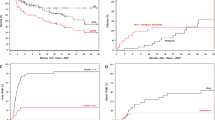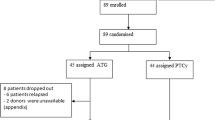Abstract
The purpose of the study was to determine the feasibility and efficacy of a reduced intensity conditioning regimen of fludarabine and melphalan for allogeneic transplantation in patients with multiple myeloma. From August 1996 to December 2000, 22 patients received a reduced intensity conditioning regimen with fludarabine and melphalan. Median age was 51 years (range, 45–64), median time from initial therapy to transplant was 36 months (range, 3–135 months). Disease phase prior to transplant was primary refractory in two patients, refractory relapse in 11 patients, sensitive relapse in eight patients and initial remission consolidation in one patient. The median number of prior therapies was five (range, 1–7), and median beta 2 microglobulin prior to transplant was 3.0 mg/l (range, 1.0–7.3). All patients received unmanipulated grafts from either HLA matched sibling donors (n = 13) or matched unrelated donors (n = 9). Eighteen patients received fludarabine 30 mg/m2 for 4 days with melphalan 140 mg/m2 as a single dose and four patients received fludarabine 25 mg/m2 for 5 days with melphalan 90 mg/m2 daily for 2 days. All 21 patients evaluable for engraftment achieved a neutrophil count of >0.5 × 109/l after a median of 12 days (range, 9–24), 18 patients achieved platelet transfusion independence after a median of 14 days (range, 8–47). All engrafting patients had 100% donor cell engraftment. Seven patients achieved a complete remission. Six patients are currently alive with a median follow-up of 15 months (range, 10–47 months). The actuarial survival and progression-free survival is 30 ± 11% and 19 ± 9% at 2 years. Non-relapse mortality at 100 days was 19 ± 10% and 40 ± 10% at 1 year. Fludarabine/melphalan combinations are feasible and allow consistent engraftment of allogeneic progenitor cells from both related and unrelated donors in patients with multiple myeloma and should be explored in patients with less advanced disease.
This is a preview of subscription content, access via your institution
Access options
Subscribe to this journal
Receive 12 print issues and online access
$259.00 per year
only $21.58 per issue
Buy this article
- Purchase on Springer Link
- Instant access to full article PDF
Prices may be subject to local taxes which are calculated during checkout
Similar content being viewed by others
References
Kyle R . Multiple myeloma: review of 869 cases Mayo Clin Proc 1975 50: 29 40
Alexanian R, Bonnet J, Gehan E et al. Combination chemotherapy for multiple myeloma Cancer 1972 30: 382 389
Alexanian R, Dimopoulos M . The treatment of multiple myeloma New Engl J Med 1994 330: 484 489
McElwain T, Powles R . High-dose intravenous melphalan for plasma cell leukemia and myeloma Lancet 1983 i: 822 824
Barlogie B, Hall R, Zander A et al. High dose melphalan with autologous bone marrow transplantation for multiple myeloma Blood 1986 67: 1298 1301
Jagannath S, Barlogie B, Dicke K et al. Autologous bone marrow transplantation in multiple myeloma: identification of prognostic factors Blood 1990 76: 1860 1866
Vesole D, Barlogie B, Jagannath S et al. High dose therapy for refractory multiple myeloma: improved prognosis with better supportive care and double transplants Blood 1994 84: 950 956
Harousseau J, Attal M, Divine M et al. Autologous stem cell transplantation after first remission induction treatment in multiple myeloma: a report of the French Registry on autologous transplantation in multiple myeloma Blood 1995 85: 3077 3085
Attal M, Harousseau J, Stoppa A et al. A prospective randomized trial of autologous bone marrow transplantation and chemotherapy in multiple myeloma New Engl J Med 1996 335: 91 99
Attal M, Harousseau J . Standard therapy versus autologous transplantation in multiple myeloma Hem Oncol Clin North Am 1997 11: 133 146
Alexanian R, Dimopoulos M, Hester J et al. Early myeloablative therapy for multiple myeloma Blood 1994 84: 4277 4282
Barlogie B, Jagannath S, Vesole D et al. Superiority of tandem autologous transplantation over standard therapy for previously untreated multiple myeloma Blood 1997 89: 789 793
Barlogie B, Jagannath S, Naucke S et al. Long term follow–up after high-dose therapy for high risk multiple myeloma Bone Marrow Transplant 1998 21: 1101 1107
Vesole D, Tricot G, Jagannath S . Autotransplants in multiple myeloma: what have we learned? Blood 1996 88: 838 847
Alexanian R, Dimopoulos M, Smith T et al. Limited value of myeloablative therapy for late multiple myeloma Blood 1994 83: 512 516
Tricot G, Vesole DH, Jagannath S et al. Graft-versus-myeloma effect: proof of principle Blood 1996 87: 1196 1198
Lokhorst H, Schattenberg A, Cornelissen J et al. Donor leukocyte infusions are effective in relapsed multiple myeloma after allogeneic bone marrow transplantation Blood 1997 90: 4206 4211
Gahrton G, Tura S, Ljungman P et al. Allogeneic bone marrow transplantation in multiple myeloma New Engl J Med 1991 325: 1267 1273
Bensinger W, Buckner C, Clift R et al. A phase I study of busulfan and cyclophosphamide in preparation for allogeneic marrow transplant for patients with multiple myeloma J Clin Oncol 1992 10: 1492 1499
Bjorkstrand B, Ljungman P, Svensson H et al. Allogeneic bone marrow transplantation versus autologous stem cell transplantation in multiple myeloma: a retrospective case-matched study from the European Group for Blood and Marrow Transplantation Blood 1996 88: 4711 4721
Bensinger W, Clift R, Martin P et al. Allogeneic marrow transplantation for multiple myeloma. Analysis of risk factors on outcome Blood 1996 88: 2787 2793
Gahrton G, Tura S, Ljungman P et al. Prognostic factors in allogeneic bone marrow transplantation for multiple myeloma J Clin Oncol 1995 13: 1312 1322
Giralt S, Estey E, Albitar M et al. Engraftment of allogeneic hematopoietic progenitor cells with purine analog-containing chemotherapy: harnessing graft-versus-leukemia without myeloablative therapy Blood 1997 89: 4531 4536
Slavin S, Nagler A, Naparstak E et al. Nonmyeloablative stem cell transplantation and cell therapy as an alternative to conventional bone marrow transplantation with lethal cytoreduction for the treatment of malignant and non malignant hematologic diseases Blood 1998 91: 756 763
Khouri I, Keating MJ, Korbling M et al. Transplant lite: induction of graft vs malignancy using fludarabine-based nonablative chemotherapy and allogeneic progenitor-cell transplantation as treatment for lymphoid malignancies J Clin Oncol 1998 16: 2817 2824
Giralt S, Weber D, Cohen A et al. Non-myeloablative conditioning with fludarabine (F)/melphalan (M) for patients with multiple myeloma (MM) Proc Am Soc Clin Oncol 35th Annual Meeting 18:6a: (Abstr. 18)
Blade J, Samson D, Reece D et al. Criteria for evaluating disease response and progression in patients with multiple myeloma treated by high-dose therapy and hemopoietic stem cell transplantation. Myeloma Subcommittee of the EBMT, European Group for Blood and Marrow Transplant Br J Haematol 1999 102: 1115 1123
Gluksberg H, Storb R, Fefer A et al. Clinical manifestations of graft versus host disease in human recipients of marrow from HLA matched sibling donors Transplantation 1974 18: 295 304
Schulman HM, Sullivan KM, Weiden PL et al. Chronic graft-versus-host disease syndrome in man. A long term clinical pathologic study of 20 Seattle patients Am J Med 1980 69: 204 217
Standing Committee on Human Cytogenetic Nomenclature. An International System for Human Cytogenetic Nomenclature 20 Cytogenet Cell Genet 1978 21: 309
Yam P, Petz L, Knowlton R et al. Use of DNA restriction fragment length polymorphisms to document marrow engraftment and mixed hematopoietic chimerism following bone marrow transplantation Transplantation 1987 43: 399 401
Bearman S, Appelbaum F, Buckner C et al. Regimen related toxicity in patients undergoing bone marrow transplantation J Clin Oncol 1988 6: 1562 1568
Kaplan E, Meier P . Nonparametric estimation from incomplete observations J Am Stat Assoc 1958 53: 457 467
Salama M, Nevill T, Marcellus D et al. Donor leukocyte infusions for multiple myeloma Bone Marrow Transplant 2000 26: 1179 1184
Alyea E, Soiffer R, Canning C et al. Toxicity and efficacy of defined doses of CD4+ donor lymphocytes for treatment of relapse after allogeneic bone marrow transplant Blood 1998 91: 3671 3680
Champlin R, Khouri I, Kornblau J et al. Reinventing bone marrow transplantation. Nonmyeloablative preparative regimens and induction of graft-versus-malignancy effect Oncology 1999 13: 621 626
Sarosy G, Leyland-Jones B, Soochan P, Cheson B . The systemic administration of intravenous melphalan J Clin Oncol 1988 6: 1768 1775
Siegel DS . Desikan KR. Mehta J et al. Age is not a prognostic variable with autotransplants for multiple myeloma Blood 1999 93: 51 54
Plunkett W, Sanders P . Metabolism and action of purine nucleoside analogs Pharmacol Ther 1991 49: 239 245
Li L, Glassman A, Keating M et al. Fludarabine triphosphate inhibits nucleotide excision repair of cisplatin-induced DNA adducts in vitro Cancer Res 1997 57: 1487 1494
Badros A, Barlogie B, Morris C et al. High response rate in refractory and poor risk multiple myeloma after allotransplantation using a nonmyeloablative conditioning regimen and donor lymphocyte infusions Blood 2001 97: 2574 2579
Peggs K, Williams C, Chopra R et al. Non-myeloablative allogeneic transplantation with adjuvant dose escalated donor lymphocyte infusions for multiple myeloma Blood 2000 96: 781a
Molina A, Sahebi F, Maloney D et al. Non-myeloablative peripheral blood stem cell allografts (PBSC) following cytoreductive autotransplants for treatment of multiple myeloma (MM) Blood 2000 96: 480a
Lalancette M, Rezvani K, Szydlo R et al. Excellent outcome of non-myeloablative stem cell transplant (NMSCT) for good risk myeloma: the EBMT experience Blood 2000 96: 204a
Barlogie B, Desikan R, Eddlemon P et al. Extended survival in advanced and refractory multiple myeloma after single agent thalidomide: identification of prognostic factors in a phase 2 study of 169 patients Blood 2001 98: 492 494
Desikan R, Barlogie B, Sawyer J et al. Results of high-dose therapy for 1000 patients with multiple myeloma: durable complete remissions and superior survival in the absence of chromosome 13 abnormalities Blood 2000 95: 4008 4012
Author information
Authors and Affiliations
Rights and permissions
About this article
Cite this article
Giralt, S., Aleman, A., Anagnostopoulos, A. et al. Fludarabine/melphalan conditioning for allogeneic transplantation in patients with multiple myeloma. Bone Marrow Transplant 30, 367–373 (2002). https://doi.org/10.1038/sj.bmt.1703652
Received:
Accepted:
Published:
Issue Date:
DOI: https://doi.org/10.1038/sj.bmt.1703652
Keywords
This article is cited by
-
Allogeneic stem cell transplantation for multiple myeloma: is there a future?
Bone Marrow Transplantation (2016)
-
Pushing the envelope—nonmyeloablative and reduced intensity preparative regimens for allogeneic hematopoietic transplantation
Bone Marrow Transplantation (2015)
-
Allogeneic hematopoietic cell transplantation for consolidation of VGPR or CR for newly diagnosed multiple myeloma
Bone Marrow Transplantation (2013)
-
Toxicity-reduced, myeloablative allograft followed by lenalidomide maintenance as salvage therapy for refractory/relapsed myeloma patients
Bone Marrow Transplantation (2013)
-
Allogeneic Hematopoietic Stem Cell Transplantation for Multiple Myeloma: What Place, If Any?
Current Hematologic Malignancy Reports (2013)



